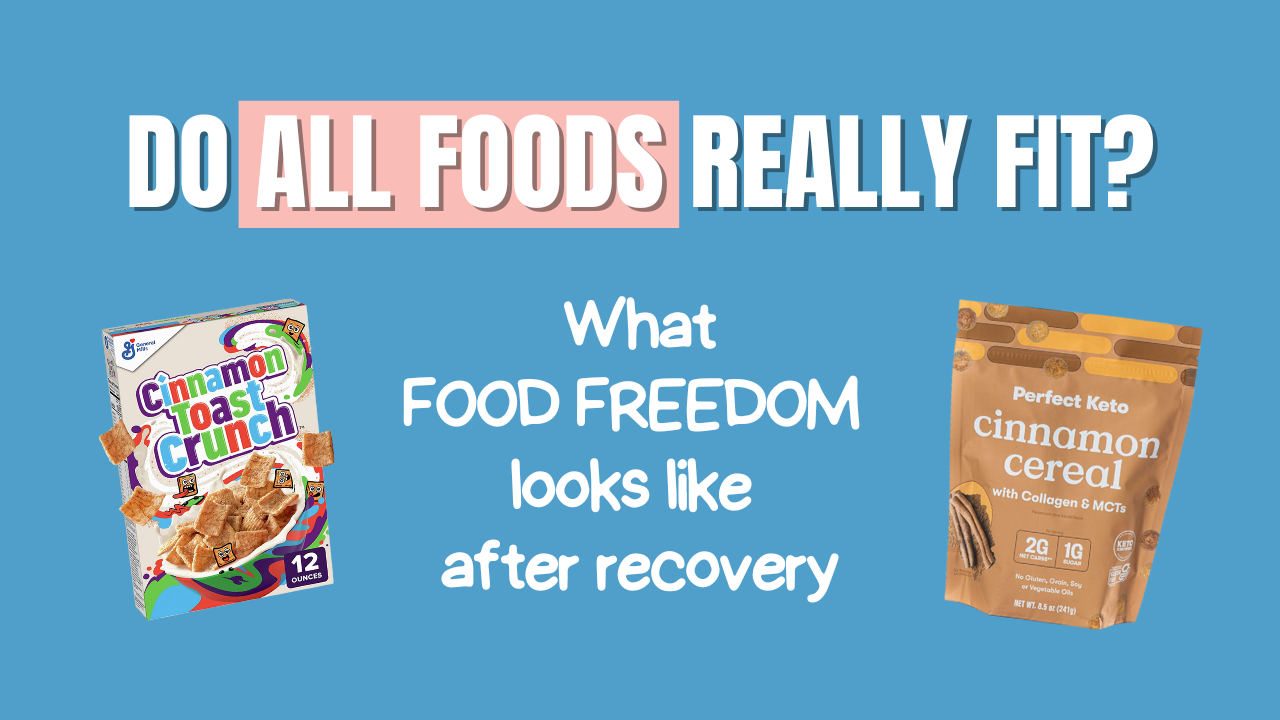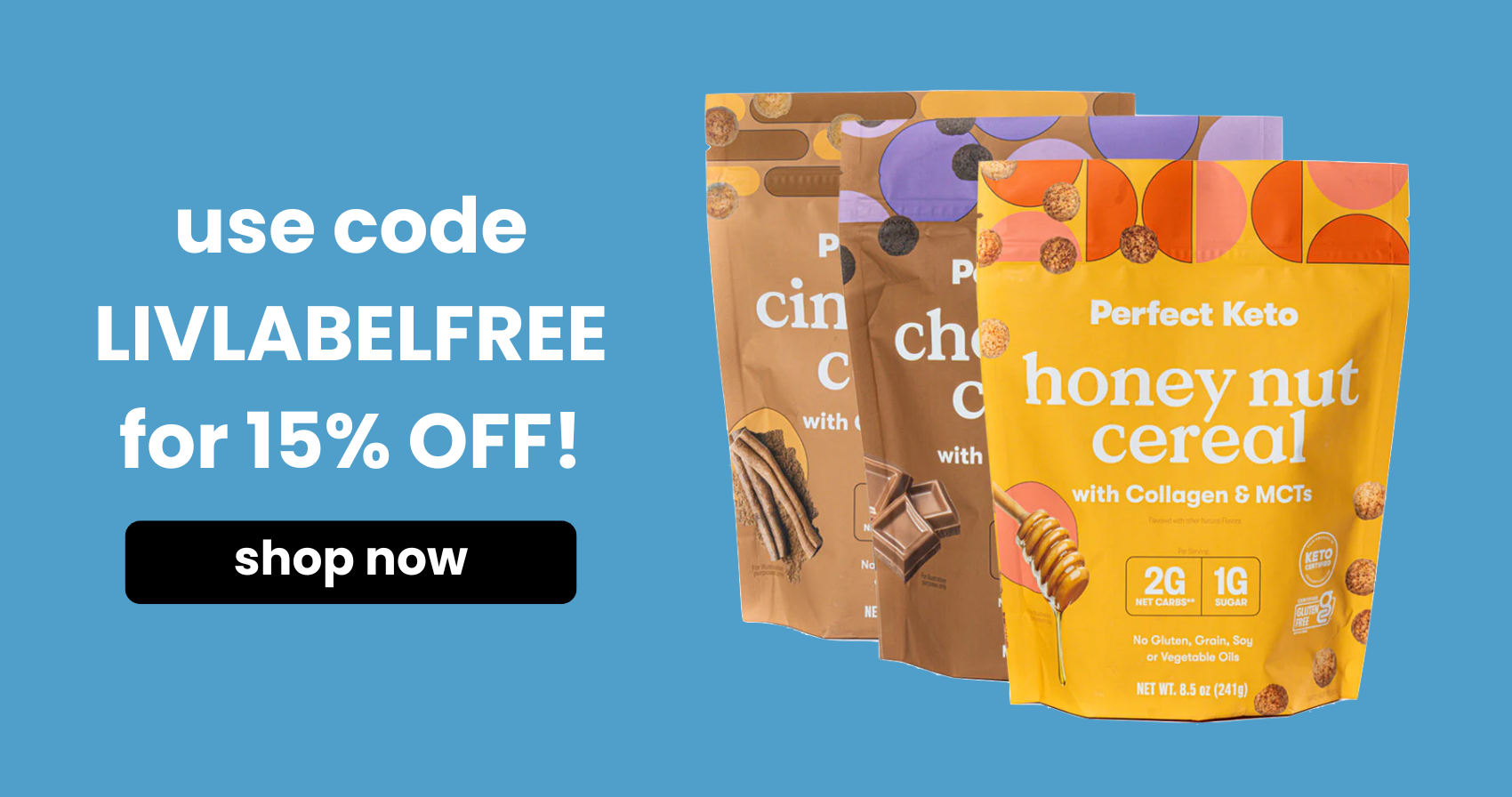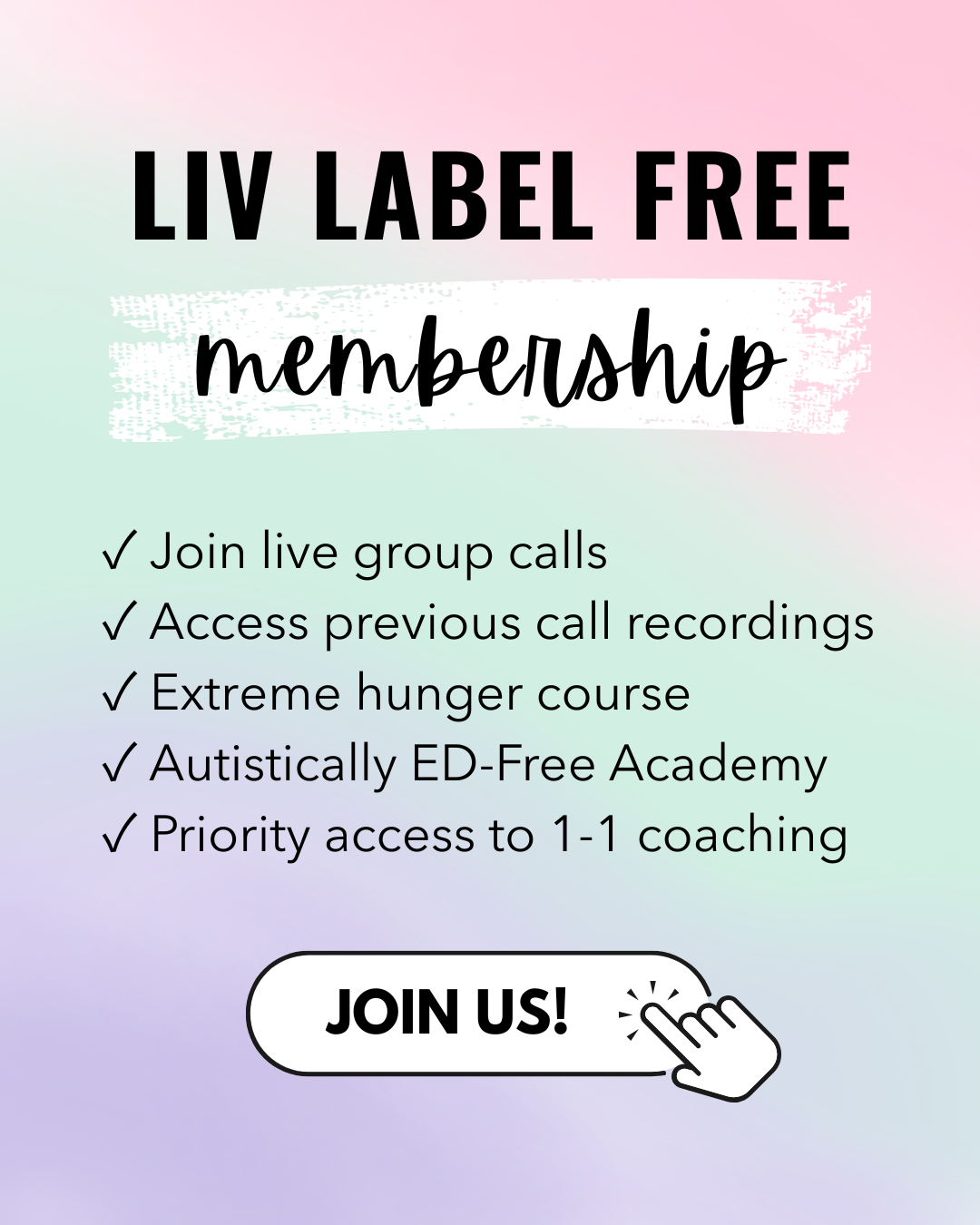Do ALL FOODS really fit? What FOOD FREEDOM looks like after recovery
Oct 17, 2022
Today we’re going to be discussing a topic that’s been on my mind for wayyy too long, and that is the truth behind the all foods fit approach and what food freedom REALLY means. Based on the comments and messages I’ve received over the past several years at this point, I’ve learned that there are LOTS of misconceptions and misunderstandings around the whole idea of what it means to honor your body in a fat-phobic and diet-culture obsessed society.
What I’m about to share in this post is at the very core of my mission with Liv Label Free, and that is my belief that we as individuals can only live a life of freedom once we fully let go of labels. And because food IS such an important part of our lives, food freedom means letting go of labels around food! But how do we do that? Keep on reading, and I guarantee you’ll walk away with a whole new perspective of what it means to enjoy all foods without limitations.
Labels are Subjective
The very first concept we must recognize when it comes to labels, is that labels are subjective! They are not facts. Let’s take the word “healthy” for example. In our diet-culture obsessed society that just loves to label everything, there are a lot of foods that have either received the label “healthy” or “unhealthy”.
The Peanut Butter Example
You may have heard that peanut butter is a “health food” as long as it’s made from 100% peanuts. And yes, this may very well be the case. I love eating 100% peanut butter! I mean oatmeal, pancakes, sandwiches - eating nut butter daily definitely helps me maintain my health!
But what about someone with a peanut allergy? Well, I don’t think I need to tell you that the peanut butter can be made with the purest peanuts of the Earth’s soils, grown in the most organic and non-GMO conditions, and harvested at the perfect time, but NONE of this matters to someone who has a peanut allergy. Consuming this peanut butter would be fatal, meaning the peanut butter is in this case NOT at all healthy!
I know this is an extreme example, but what I am illustrating here, is that the EXACT SAME FOOD can be seen as both healthy and unhealthy; it all depends on the context around the food!
Labels around Food & Recipes
Now that we understand the importance of context when it comes to labeling, let’s talk about the dangers of labeling foods or recipes as “diet-promoting”, “orthorexic”, or “triggering”.
If you follow me on Instagram or ever visited this website when I still shared recipes, you know that they were often high-protein, plant-based, gluten-free, you get the gist. I’ve also shared about products before that are labeled as keto, paleo, dairy-free, and honestly, the list is endless because so many foods happen to have labels!
Anyways, there was this one time when I shared a recipe that was low-carb and high-protein, and I was immediately accused of promoting an “orthorexic and triggering recipe on a recovery account”. When I read this, majorrrr alarm bells went off in my head because there are so many negative labels going on here!
First off, a recipe or food itself cannot “be orthorexic”. Food is an inanimate object! A behavior can be orthorexic, such as eating a certain food because you’re afraid of eating something else. In the case of the low-carb, high-protein porridge recipe I shared, the recipe itself is just made from food that happens to be low-carb and high-protein, just like a piece of steak is low-carb and high-protein! But if I were to post a thick piece of meat on my Instagram, I can almost guarantee I wouldn’t receive any negative comments because steak packages don’t usually have “the high-protein, low-carb choice!” printed on their packaging.
Second, a recipe or food cannot “be triggering”. Again, food is an inanimate object! Someone may feel triggered by the sight of a certain food or recipe, but just as with labels, this emotion is subjective. If the recipe itself was triggering, that would mean every single person to view that recipe would feel triggered. Obviously, that’s not the case! One person can see the recipe and think “oh, yum, I’m so gonna try that!” completely without thinking about other foods they would need to eat before or after, and another person - perhaps the one who commented on my post - will think “oh no, my eating disorder now wants to eat low-carb because I saw this recipe.” If that person then acts on this eating disorder thought by eating low-carb instead of what they may have eaten to challenge their eating disorder, this could be perceived as an orthorexic behavior!
What's your Intention?
In mentioning that a behavior can be orthorexic, notice that this is only the case if you are choosing to eat something out of fear. If you are afraid of eating carbs, eating the low-carb porridge would most likely be stemming from the orthorexia. But what about if you’re fully recovered from an eating disorder like me, just ate a huge slice of cake, and are craving a lighter version of porridge? What if you want to nourish your body, get in some extra veggies, pack in some protein, and get creative in the kitchen at the same time? If you are coming from a place of love for your body and your life, eating the low-carb porridge is a completely healthy choice!
Just as we learned about the importance of context in the peanut butter example, it’s all about the intention when it comes to making food choices that support YOUR unique version of health. When you are making your food choices out of fear, it’s probably not healthy. When you are making your food choices out of love, it’s most likely healthy!
“Recovery Account”
Just before I move on to talking about products and products having certain labels on their packaging, I want to address the label “recovery account”. I honestly find it very ironic to be explaining this considering my brand’s name is literally Liv LABEL FREE, but clearly that’s not clear to some people, so here we are! I don’t see my Instagram account as a “recovery account”. Sure, I may have started it when I was “in recovery” from my eating disorder, but as I’ve grown and evolved as a person, my account has become so much more than just a place in which I used to document my food and my struggles. My account has literally become an “account” of my personal journey, in which I share whatever I choose to share! It’s not a recovery account, it’s not a recipe account, it’s not a health account and it’s not even a lifestyle account - because none of those labels even come close to housing the intricacy of myself as a human. My Instagram account is simply my instagram account - nothing more, nothing less.
Labels around Products & Packaging
Now that I’ve shared my thoughts on recipes, let’s talk about the term “diet food” and how this plays into the marketing of certain products. As we all know, it’s hard to find any kind of packaged food nowadays that doesn’t claim to be a gazillion different things. Whether this is a nutrition bar that’s sugar-free and high-protein or a bread that’s gluten-free and high-fiber, companies will do anything to maximize the chances that their products will sell. And what sells better than diet labels in a diet-culture-obsessed society? You guessed it! Packages that are covered in diet labels.
Because you know I love examples, let’s take the example of one of my favorite cereal brands, Perfect Keto. Aside from the obvious keto label in the brand name, this cereal is marketed as being low-carb, high-protein, and made without gluten, soy, or added sugars.
Perfect Keto Cereal - diet food or just food?
When I posted this cereal on my Instagram a while back, I immediately got a message saying this was a “diet food” and was completely going against the purpose of my account which is to ditch diet culture. I mean AHHH! A food itself cannot be a “diet food”, just like a recipe cannot “be orthorexic” or “triggering”! The cereal itself is simply a product of all of the ingredients used to make it, poured into a bag, and then stamped with 20 different labels.
So even though this company Perfect Keto is marketing their cereal to apply to all of these different diets, I do not consider the cereal itself to be a “diet food”. Why not? Again, it all comes back to intention. If you’re craving Cinnamon Toast Crunch, but you tell yourself you “can’t” have Cinnamon Toast Crunch because it’s “unhealthy” and you’re on a “diet” and then buy the Perfect Keto Cinnamon Cereal instead, you’re coming from a place of restriction and fear. Your intention behind buying the Perfect Keto cereal would be diet-oriented and thus translates the food into a “diet food”.
On the other hand, if you’re looking for a new, tasty breakfast that will satisfy you in the morning and not leave you with a sugar hangover, you might want to choose the Perfect Keto cereal because it will provide you with just that! In this case, eating the so-called “healthy” cereal is coming from a place of love for yourself, which truly does make it healthy! If you ARE interested in trying Perfect Keto cereal for yourself and it’s coming from a place of love, you can use my code LIVLABELFREE on their website to get 15% off your order!
Now, this does NOT make the Cinnamon Toast Crunch UNHEALTHY. If you are choosing the Cinnamon Toast Crunch because that’s what’s going to challenge your eating disorder, then you need to choose the Cinnamon Toast Crunch because ultimate health means being free from your eating disorder! In the same vein, choosing the Perfect Keto cereal would be UNHEALTHY if you’re doing it to please your eating disorder.
What ALL FOODS FIT really means
As you can see, there’s a common theme throughout all of this - your food choices depend on the context and your intention behind them. Foods and recipes simply cannot be labeled as morally “good” or “bad” based on how they are presented or marketed, because food simply does not have moral value! Food is food and food is nourishment.
By attaching labels to food such as “healthy” or “unhealthy”, what you’re doing in essence, is attaching power to an inanimate object. And since when did an inanimate object deserve to have so much power over you? YOU get to decide how you view food meaning YOU also get to decide to have food freedom.
To me, food freedom means being able to go for the cake made with butter, cream, and sugar when I feel like it AND it means being able to eat the smoothie bowl or the oatmeal or the low-carb protein bar when I feel like it. To me, the idea of “all foods fit” literally means ALL foods fit, regardless of their nutritional value or associated labels.
So, with that said, here’s your permission slip to honor your body in ALL of its wants and needs. Having extreme hunger and craving all the cookies, ice cream, and donuts? Go eat all the cookies, ice cream, and donuts! Or maybe you’re reading this and are really craving a big huge salad! If that’s the case, have a big huge salad! Whatever you do, make sure you’re acting from a place of love for your body - your body is doing everything it can to keep you alive, so don’t you think the least you can do is treat it with respect?
If you want to learn how to make peace with ALL foods and embrace the label-free lifestyle, learn more about 1:1 Coaching with me here!





